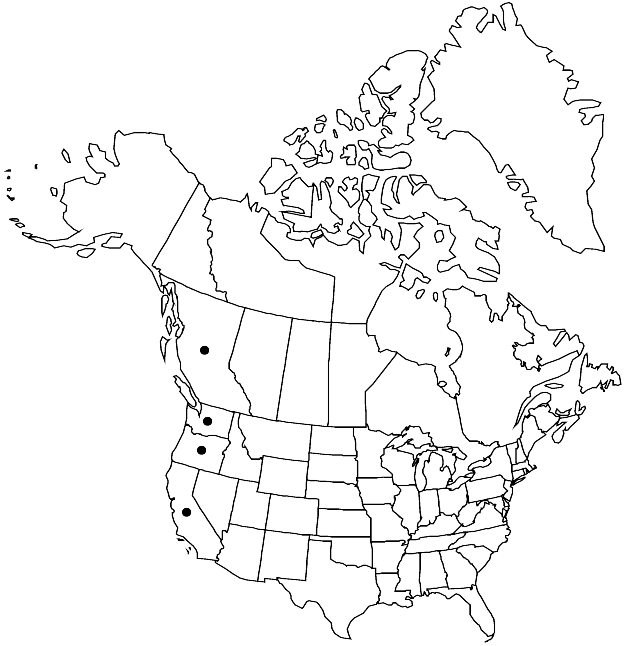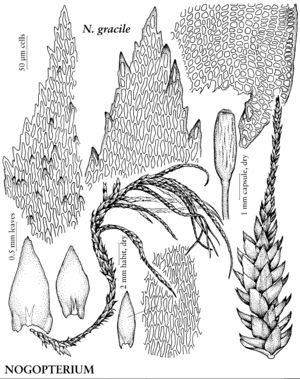Difference between revisions of "Nogopterium gracile"
Novon 21: 424. 2011.
FNA>Volume Importer |
imported>Volume Importer |
||
| (6 intermediate revisions by 2 users not shown) | |||
| Line 9: | Line 9: | ||
|special_status={{Treatment/ID/Special_status | |special_status={{Treatment/ID/Special_status | ||
|code=F | |code=F | ||
| − | |label= | + | |label=Illustrated |
}} | }} | ||
| − | |basionyms={{Treatment/ID/ | + | |basionyms={{Treatment/ID/Basionym |
|name=Pterigynandrum gracile | |name=Pterigynandrum gracile | ||
|authority=Hedwig | |authority=Hedwig | ||
| + | |rank=species | ||
| + | |publication_title=Sp. Musc. Frond., | ||
| + | |publication_place=80. 1801 | ||
}} | }} | ||
|synonyms={{Treatment/ID/Synonym | |synonyms={{Treatment/ID/Synonym | ||
|name=Pterogonium gracile | |name=Pterogonium gracile | ||
|authority=(Hedwig) Smith | |authority=(Hedwig) Smith | ||
| + | |rank=species | ||
}} | }} | ||
|hierarchy=Leucodontaceae;Nogopterium;Nogopterium gracile | |hierarchy=Leucodontaceae;Nogopterium;Nogopterium gracile | ||
| Line 33: | Line 37: | ||
|elevation=low to moderate elevations (0-1100 m) | |elevation=low to moderate elevations (0-1100 m) | ||
|distribution=B.C.;Calif.;Oreg.;Wash.;South America (Brazil);Europe;sw Asia;Africa. | |distribution=B.C.;Calif.;Oreg.;Wash.;South America (Brazil);Europe;sw Asia;Africa. | ||
| − | |discussion=<p>J. Podpěra (1954) reported Nogopterium gracile from eastern Ontario, but according to R. R. Ireland et al. (1987), the Canadian distribution is restricted to British Columbia. The calyptra was described by A. J. Grout (1928–1934, vol. 3) as cucullate, with few hairs. Nogopterium gracile may be confused with Antitrichia californica; the two species are often found growing together. Nogopterium gracile is distinguished from Antitrichia by its papillose medial laminal cells; short, double (or rarely absent) costa; plane leaf apices; dull appearance due to papillose leaves; and closely pinnate branches that, when dry, usually arch in the same direction, resembling the foot of a bird. Nogopterium gracile and Bestia longipes may also be confused. Bestia longipes never has attenuate branches; the leaves are somewhat plicate and recurved at the base; the laminal cells are smooth; the distal laminal cells are longer, to 5:1; and the single costa extends at least to mid leaf. Nogopterium gracile is known to accumulate large amounts of heavy metals (L. Rasmussen 1975). Decline of populations in northern Europe has been attributed to air pollution.</p> | + | |discussion=<p>J. Podpěra (1954) reported <i>Nogopterium gracile</i> from eastern Ontario, but according to R. R. Ireland et al. (1987), the Canadian distribution is restricted to British Columbia. The calyptra was described by A. J. Grout (1928–1934, vol. 3) as cucullate, with few hairs. <i>Nogopterium gracile</i> may be confused with <i>Antitrichia californica</i>; the two species are often found growing together. <i>Nogopterium gracile</i> is distinguished from <i>Antitrichia</i> by its papillose medial laminal cells; short, double (or rarely absent) costa; plane leaf apices; dull appearance due to papillose leaves; and closely pinnate branches that, when dry, usually arch in the same direction, resembling the foot of a bird. <i>Nogopterium gracile</i> and <i>Bestia longipes</i> may also be confused. <i>Bestia longipes</i> never has attenuate branches; the leaves are somewhat plicate and recurved at the base; the laminal cells are smooth; the distal laminal cells are longer, to 5:1; and the single costa extends at least to mid leaf. <i>Nogopterium gracile</i> is known to accumulate large amounts of heavy metals (L. Rasmussen 1975). Decline of populations in northern Europe has been attributed to air pollution.</p> |
|tables= | |tables= | ||
|references= | |references= | ||
| Line 42: | Line 46: | ||
-->{{#Taxon: | -->{{#Taxon: | ||
name=Nogopterium gracile | name=Nogopterium gracile | ||
| − | |||
|authority=(Hedwig) Crosby & W. R. Buck | |authority=(Hedwig) Crosby & W. R. Buck | ||
|rank=species | |rank=species | ||
| Line 56: | Line 59: | ||
|publication title=Novon | |publication title=Novon | ||
|publication year=2011 | |publication year=2011 | ||
| − | |special status= | + | |special status=Illustrated |
| − | |source xml=https:// | + | |source xml=https://bitbucket.org/aafc-mbb/fna-data-curation/src/2e0870ddd59836b60bcf96646a41e87ea5a5943a/coarse_grained_fna_xml/V28/V28_935.xml |
|genus=Nogopterium | |genus=Nogopterium | ||
|species=Nogopterium gracile | |species=Nogopterium gracile | ||
Latest revision as of 21:39, 5 November 2020
Stems 1.5–8 cm, branches many, 0.5–2 cm, closely pinnate, appearing fascicled, secund-ascending, julaceous, apices strongly attenuate, sometimes elongate, flagelliform. Leaves 0.5–2 × 0.3–1.2 mm; apex concolorous; alar cells strongly differentiated, 6–10 µm; laminal cells 15–46 × 5–8 µm. Perichaetial leaves 2.5–3 × 0.7–0.8 mm; paraphyses 0.6–0.8 mm. Seta reddish, 0.8–1.2 cm, twisted, smooth. Capsule light brown, symmetric, 2–3 mm; annulus 2- or 3-seriate; operculum 0.4–0.5 mm; peristome 0.3–0.4 mm; exostome teeth erect; endostome segments 0.3–0.4 mm. Calyptra unknown. Spores round, 11–18 µm, papillose, brown.
Phenology: Capsules mature year-round.
Habitat: Forested mountains, rock, boulders, trunks and base of hardwood trees, soil
Elevation: low to moderate elevations (0-1100 m)
Distribution

B.C., Calif., Oreg., Wash., South America (Brazil), Europe, sw Asia, Africa.
Discussion
J. Podpěra (1954) reported Nogopterium gracile from eastern Ontario, but according to R. R. Ireland et al. (1987), the Canadian distribution is restricted to British Columbia. The calyptra was described by A. J. Grout (1928–1934, vol. 3) as cucullate, with few hairs. Nogopterium gracile may be confused with Antitrichia californica; the two species are often found growing together. Nogopterium gracile is distinguished from Antitrichia by its papillose medial laminal cells; short, double (or rarely absent) costa; plane leaf apices; dull appearance due to papillose leaves; and closely pinnate branches that, when dry, usually arch in the same direction, resembling the foot of a bird. Nogopterium gracile and Bestia longipes may also be confused. Bestia longipes never has attenuate branches; the leaves are somewhat plicate and recurved at the base; the laminal cells are smooth; the distal laminal cells are longer, to 5:1; and the single costa extends at least to mid leaf. Nogopterium gracile is known to accumulate large amounts of heavy metals (L. Rasmussen 1975). Decline of populations in northern Europe has been attributed to air pollution.
Selected References
None.
